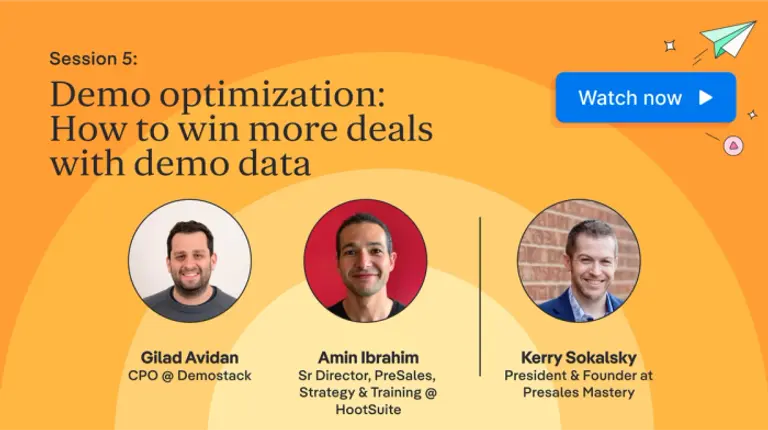A B2B prospect has shown interest in your product or service, so what should you do? Throw an office party? Call in the CEO? Panic? Nope—it’s time to set up a discovery call. The discovery call is one of the most critical conversations you will have with your prospects, setting the scene for a positive partnership.
Engaging prospects through a call helps you define goals and get buy-in as early as possible. For most companies, the conversion rate from discovery calls to sales is about 10-30%, with 15% of organizations seeing a rate above 30%.
Sometimes, this conversion success is not one-and-done—discovery is a process, not a single event, and the discovery call is the catalyst that gets the wheels turning.
What is a discovery call, and why is it so important?
A discovery call is your first conversation with a prospect after they show interest in your business. The call is an opportunity to better understand your prospect’s current situation, business goals, and pain points.
The goal of the discovery call is to determine whether the prospect is a good fit for your business and vice versa. If all goes well, each call should end with a qualified lead that can be passed to sales.
What’s the difference between a discovery call and a sales call?
The clue is in the name—a discovery call gathers information about the prospect’s organizations and needs. It isn’t the space to pitch your product or service, which is what happens on a sales call. Instead, a discovery call is a space to focus on the prospect’s pain points. It is usually shorter than a sales call and can take only 15-30 minutes.
What are the benefits of discovery calls?
Discovery calls offer many critical benefits, including:
- Establishing Trust and Credibility - The discovery call is a perfect opportunity to develop a foundation of trust by demonstrating your expertise and consideration for the prospect.
- Building Stronger Relationships - Use the call to show your prospects that you understand and recognize their pain points and goals, proving that you have their best interests at heart.
- Finding More High-Value Leads - This call is the ideal time to qualify leads, gauge the prospect’s intent and interest, and determine whether they are suitable customers for you.
- Overcoming Obstacles: Now that you’ve got the prospect on the phone, it becomes an opportunity to overcome any roadblocks or concerns the prospect has. Sales enablement tools like a personalized demo are the ultimate sidekicks for positive persuasion.
- Gain Valuable Insights - You can get to know your prospects’ pain points and business challenges on a deeper level that no desk-based research would uncover.

12 Essential Tips to Maximize Discovery Call Success
1. Pre-Call Preparation is Essential
You know the old saying: Fail to prepare, prepare to fail. Before the discovery call, invest time researching the company and the relevant decision-makers. You can use your research to prepare questions and show prospects that you already have a foundational understanding of their requirements and pain points. This info will come in handy if you decide to prepare a demo.
Typically, sales reps prepare and ask about 10- 25 questions. Some good places to begin your research include:
- The ‘About us’ page on the company’s website.
- The company’s LinkedIn page.
- The prospect’s LinkedIn page.
- Recent company news, such as investment rounds.
2. Start with a Strong Opening
You only have seven seconds to make a good first impression, so the initial moments can set the tone for the rest of the discovery call. Build a rapport by demonstrating enthusiasm and highlighting the value of the discovery call for shared understanding and relationship building.
Although the discovery call isn’t the time to pitch your product (the longest sales rep monologue should last about 2 minutes and 43 seconds), you can still provide a strong (and brief) opening statement summarizing:
- Who you are and your role.
- What your company does.
- The goal and agenda of the call.
- Small talk with the client. Even a simple ‘How is your day going?’ can start things on the right foot.
3. Active Listening is Crucial
Preparing a list of great questions before the discovery call is essential, but it doesn’t need to be set in stone. The golden advice for discovery calls is to practice active listening and adapt to the tone and direction of the conversation – then, you can provide a reply that is aligned with their needs.
Active listening means demonstrating attentiveness to the speaker using techniques like body language and affirmation. Repeating and clarifying their comments helps you prove to the prospects that you understand their business and requirements and, most importantly, that you are listening to them. If you engage with them, they will engage with you.
4. Ask the Right Questions to Uncover Needs
The last thing your prospects want is to feel like they’re in an interrogation session. Rather than probing as much as possible, ensure you ask high-value and open-ended questions that encourage the prospect to give a detailed answer.
Example questions could be:
- Tell me about your company’s operational, organizational, and financial goals.
- What problems are you looking to solve with X?
- What is your team’s current process for X?
- How urgent is this requirement?
- Can you describe your ideal solution for X?
- What would a successful outcome look like for this project?
As you uncover their business needs, note which critical pain points you can address at the demo stage.

5. Position Your Solution as the Answer (But Don't Pitch!)
After using your pre-prepared questions to uncover the company’s short- and long-term goals, use this information to your advantage and introduce relevant benefits and use cases of your product or service.
It’s a fine line between pitching and chatting. Rather than diving into the hard sell, you can try the ‘feel-felt-found’ objection technique:
- Feel: Empathize with the prospect’s concern.
- Felt: Use a case study or testimonial to highlight how other customers felt the same way.
- Found: Explain how other customers found what they wanted using your product or service.
Judging by the prospect’s level of interest at the end of the call, you can offer them a demo. Although the discovery call is all about the prospect, you still need to shine a spotlight on your product to garner their interest, and a demo is an effective and engaging way to do this.
You should ideally strive to demo your solution at every pipeline meeting, and the discovery call is no different. For example, an adaptable solution like Demostack can generate easy-to-use display demos for every use case, including one tailored for a discovery call

6. Handle Objections with Confidence
Discovery calls can get tricky, and the prospect may throw a few curveballs your way. If so, take the time to acknowledge their concerns and highlight proof points of your product or service.
A personalized product demo, use cases, and customer stories can bolster your response and reassure prospects, and empathetic language like ‘Many of our customers initially felt the same way’ can keep the conversation personal.
7. Confirm Their Business Challenges
During discovery calls, one of the best practices is to take notes and document the information you gather, which you can share with sales enablement, sales engineering, and marketing colleagues.
Don’t be afraid to ask prospects to confirm or further explain the features or goals of their company’s product or service. Asking for more information encourages them to dig deeper and provide more detail about their business challenges.
You can also use your meeting notes to customize the demo further. For example, some prospects may want to see ROI, usability, or integration capabilities.
8. Identify Their Decision Criteria
You haven't yet sealed the deal, even if the call was successful. At this stage, you can ask about the company's decision-making process, such as:
- Who is involved?
- Who makes the final call?
- Are there any upcoming or unforeseen challenges, such as an upcoming budget review?
- What are their timelines?
This detail helps you advise your sales team colleagues about which stakeholders to engage and which sign-off processes to prioritize.
9. Set Clear Expectations for the Next Steps
You can set clear next steps at the end of the call, including action points, task ownership, and timelines. Document this information for easy referencing. Lastly, don’t forget to secure their commitment. It’s unlikely that you will get a firm ‘yes’ on the discovery call, but you can move them further down the sales funnel by inviting them to watch a demo or book another call.
10. CRM Updates
You’ll gather tons of information on the discovery call, but it’s what you do with this information that matters. Following the call, you can fill your CRM with the unstructured data. Rather than leaving quick notes, create mandatory fields such as moving a contact or company from the discovery phase to ‘qualified pipeline’ or ‘closed lost.’ This best practice helps you structure the data and see its total value.
11. Leverage Technology
Technology can help you deliver a streamlined experience with your prospect, even during the initial discovery stages. Simple automation additions like recording and transcribing can help improve communication, and CRM tools bring your marketing, sales, and customer service requirements together in one place.
Don’t forget where the demo slots into the picture. For example, you can integrate Demostack with your CRM to seamlessly track demo engagement and personalize follow-up actions.

12. Continuously Improve
‘Never stop learning’ is an awesome attitude to have. After the call, re-watch the recording (or listen to the transcript) to analyze your approach. Your colleagues can provide constructive feedback to help you level up in the next discovery call.
Continuous improvement also applies to your product demos. By choosing a tool with built-in analytics features, you can track engagement, identify your prospect’s areas of interest, and measure the demo’s impact – all this info helps you better prepare for next time.
Be Demo-ready During the Discovery Call
Since discovery calls are short, the emphasis should be on gathering valuable insights, not on the volume of information. Likewise, from your prospect’s perspective, they want to see you provide quality proof points about your product or service, and a demo is the best way to do so.
Demostack is a powerful sales enablement and demo automation platform that delivers personalized, interactive, and data-driven demos to your prospects. It automates the demo creation and delivery processes, enabling you to focus on the quality of the discovery call. With Demostack, you can showcase the value of your product or service and provide prospects with hands-on product experience.
Want to see Demostack in action? Take it for a spin by booking a demo.



